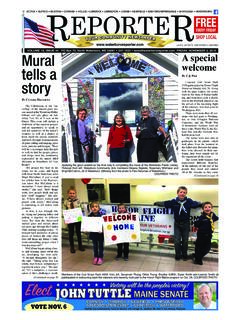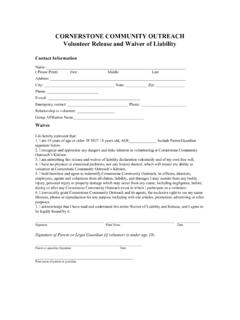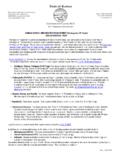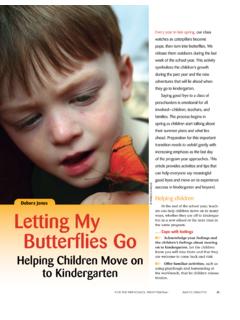Transcription of S u m m a r y o f C a l u m e t H e r i t a g e C o n f e ...
1 Summary of Calumet Heritage Conference Poster Board Breakout Session Calumet National Heritage Area Management Planning Brainstorm 19th Annual Calumet Heritage Conference Saturday, October 20, 2018 During the lunchtime breakout session of the 19th Annual Calumet Heritage Conference, attendees were invited to participate in a brainstorming activity focused on the regional priority areas identified in the Calumet National Heritage Area Feasibility Study. Posters were placed at participants tables, and each poster addressed one of the following priorities: The Arts, Cultural Heritage/Historic Preservation, Economic Development, Education, Environment and Stewardship, Recreation, and Wayfinding and Branding . Discussions were guided by the following three questions: is the best example that you have seen of these goals being reached outside of the Calumet region? do you think is the most useful to bring back to the region? group would you partner with to make this happen?
2 The results of this activity are organized by priority area below. Each section includes the description of the priority area as outlined by the Calumet National Heritage Area Feasibility Study, followed by a summary of the responses. Groups varied in their approaches to the activity and produced a range of responses. While the activity was intended for the questions to build on each other ( , Question 2 would build on Question 1, and Question 3 would build on Question 2), each group was welcome to conduct the activity as they wished. Because of the variability in the groups approaches to the activity, the responses show varying connections between the questions. The information gathered during this brainstorming activity will inform the Calumet National Heritage Area management planning process. Priority Focus: The Arts Description: The region s landscape and heritage are significant sources of artistic inspiration, especially with attention-grabbing proximity of nature and industry.
3 There is a thriving arts community in the Calumet region, but it is not well recognized. Summary of Poster Activity: Responses to Question 1 are as follows: Bethlehem Steel in PA Pilsen Art Walk in Chicago Open Art Studios/galleries Steelworkers Park, Chicago Park District UK Steel Mill Opera Munster, Indiana monument outside the Hammond Times Newspaper building Based on the second question, the group proposed the following ideas: Use phragmites (invasive species rampant in the Calumet region) for papermaking or in artwork with the SkyArt Chicago organization. Inventory arts/artists in the Calumet region Create website with a story map for collecting visitors stories Self-guided tours and art walks at Hammond, Pullman, and Beverly Open studios to demystify the art making process Tap into universities and high schools through SkyArt, Lubeznik Art Center, and the Beverly Arts Center. Partnership recommendations to further previously given examples are as follows: Pullman, Whiting arts, Chesterton Art Center, and the Lubeznik Indiana Art Center Existing guilds, such as woodworkers, and weavers local galleries Dance groups, and acting companies (particularly those which feature culturally based performances) Chicago Park District Priority Focus: Cultural Heritage/Historic Preservation Description: The communities of the Calumet region are sites of significant cultural history.
4 But, sites of significance are often unrecognized and unappreciated. Summary of Poster Activity: The following best examples were gathered: Hudson, Wisconsin Portsmouth, New Hampshire walking tour Great Smoky Mountains National Park Blue Ridge National Park The Eastern Band of Cherokee Indigenous Peoples Western North Carolina Artist Trail, Asheville, North Carolina, Museum of Appalachia -- collaboration to gather and raise multiple voices and perspectives for the benefit of cultural heritage/historical preservation Walk through industrial ruins Freedom Trail in Boston New Philadelphia, Illinois Bishop Hill, IL, active community events Mary s City of David tours and vegetarian dinner with advance reservations San Juan Capistrano (California) Indianapolis (Canal Development) Indiana History Museums In no specific order, the conference attendees also discussed activities or other things that could be brought back to the region from outside the Calumet region.
5 Bridging past culture to present Pop-up museums Geocaching Geocaching/walking tour with/of each community Active storytelling Signage about area Ample brochures and information Integrate new technology, such as smartphone apps with any tours or other public information Communication The following are groups that if partnered with may be able to apply the same practices and programs as the examples mentioned above: National Park Service NCHP Illinois Department of Natural Resources Indiana Department of Environmental Management State Historic Preservation Offices Local grassroots group and organizations Local historical societies Art and cultural groups City and government agencies Priority Focus: Economic Development Description: Industry has been a key identifying factor and the backbone of the Calumet region. The region s industries are in flux, making stability and redevelopment key goals. Conserving the industrial heritage of the Calumet region is important, but should be coupled with efforts to support existing industries and attract new investment and build on environmental and community assets.
6 Summary of Poster Activity: A range of examples of economic development from outside and within the Calumet region were discussed, listed below. Some are followed by partnership suggestions. The Plant Chicago, which has an indoor farmers market, Brewery, and other local, sustainable business in a hub. oPartner with The Plant or implement their model. Farmers Markets in Nashville and New Orleans, which have a good balance of strengths-focus on industry, green space, and where culture is balanced. oIn order to create spaces that balance industry, green spaces, and industry it is suggested that the Calumet region partner with local governments and/or banks that own defiant or abandoned property that can be flipped into open spaces or community based businesses. Pittsburgh, PA with a regeneration from dirty manufactory to sustainable innovative industries, which have regenerative qualities that bring up the use of the industrial past to re-invigorate inventiveness and creative thinking among community members.
7 This may materialize as heritage pride or even artistic ingenuity with the material present in the Calumet region. oIn order to bring this idea or path to fruition we should partner with educational institutions within the Calumet, such as Northwestern Indiana University, Purdue-Calumet, College of St. Joe, and ITT (at the construction level). Looking outside the Calumet region it might be in the Calumet Heritage Partnerships best interest to seek the advice or help from the Pittsburg groups/gov/schools/social entrepreneur who revitalized Pittsburgh. The Clarks River National Wildlife Refuge (Paducah, Kentucky), which contains diverse community engagement by local landowners, mining companies, hunters oPartner with the Sierra Club, Audubon Society, and the Calumet Ecological Park Assessment. Priority Focus: Education Description: The cultural and environmental heritage of the Calumet region offers unique opportunities to engage children and adults in place based learning. A National Heritage Area could provide a network to facilitate the creation, connection, and enhancement of educational programming around environmental conservation and stewardship, economy, the arts, cultural heritage and historic preservation, and interpretation.
8 Summary of Poster Responses: The education examples are connected loosely with the ideas and partners provided. Four sites or programs were suggested: Detroit, MI; Lowell, MA; the Cuyahoga Conservancy, and Rivers of Steel National Heritage Area in Pittsburgh, PA. These sites were seen to potentially have the support from schools and major educational institutions One question was: H ow do we bring it to them, or do they come to us? This group also proposed organizations, groups, and institutions in and outside the Calumet region we can partner with, such as the Dunes Learning Center and various schools or educational systems with programs aimed towards heritage and environmental education. Priority Focus: Environment and Stewardship Description: The Calumet region has played an important role in conservation, ecological study, and environmental protection. The area continues to possess a rich conservation ethic, ecological significant sites, and outstanding services by agencies to protect the environment and public health.
9 Summary of Poster Activity: There was continuity between Questions 1, 2, and 3 for this group: Hot Springs National Park in Arkansas has exemplary trail planning and connectivity to various environmentally significant locations. Partner with the Southland Chamber of Commerce, the Indiana Visitors Center, and various local chambers of commerce. Galena, Illinois has well-defined land conservation, cultural preservation, draw for tourism, and access points for river to trail recreation. Tourism and transportation may be the greatest benefit to the Calumet region of Illinois and Indiana Partner with a transportation alliance, such as the Active Transportation Alliance in Chicagoland. Agricultural programs that allow for high schoolers, university students, and local citizens to join in conservation work and become stewards of their community. Establish a cooperative development of site/area based cultural recognition, such as why a place is important, how does this impact the community, and who are we reaching.
10 Partner with the department of natural resources in both Illinois and Indiana. Metropolitan Water Reclamation District of Greater Chicago uses comprehensive planning and implementation and Interagency cooperation Develop a partnership with the Metropolitan Water Reclamation District of Greater Chicago, the Illinois and Indiana EPA and DNR, Region 5 US EPA, various navigation organizations on waterways and Lake Michigan, the Chicago Park District, and the Forest Preserve District of Cook County. I llinois Department of Natural Resources and the Prairie Research Institute at the University of Illinois. Implement their models of placing parcels into INPC status for protection and as a means to measure and quantify a healthy parcel . Priority Focus: Recreation Description: The Calumet region historically has contained significant places to relax and to play. The region could benefit from improving the trails system, improving existing and developing new recreational sites, increasing access to waterways, and increasing ecotourism.









